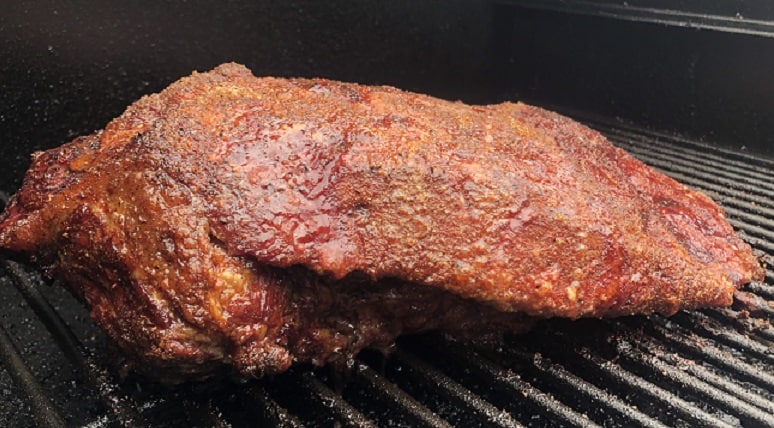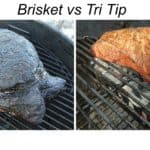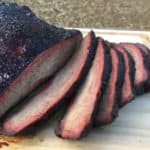When you are smoking a brisket there comes a time when you are going to want to wrap it in either aluminum foil or butcher paper. You don’t have to wrap a brisket but it does usually result in a better product.
Figuring out exactly when you should wrap the brisket is pretty easy once you understand why wrapping is important.
The quick answer for “When to wrap a brisket?” is: Wrap the brisket after 5-6 hours of smoking at 250F when the internal temperature of the brisket reaches 160F.
Let’s take a closer look at:
- Why You Should Wrap a Brisket
- Aluminum Foil vs Butcher Paper
- Risks of Wrapping a Brisket

Why You Want to Wrap Briskets
Wrapping your brisket has the following benefits.
- Protects the Brisket
- Speeds the Cooking Process (Pushes Through the Stall)
- Makes the Resting Period Easier
Protect the Brisket’s Flavor and Color
As the brisket cooks in the smoker the rub is going to set up and the crust is going to take on a beautiful reddish/mahogany color. If you do not wrap the brisket then the color is going to continue to darken and it can end up looking like a meteorite.
I have found that when I am cooking briskets that the rub has usually set and I have the color I want when it hits an internal temperature of 160F. It typically takes about 5-6 hours of smoking at 250F to reach this temperature. You results will vary based on the size of your brisket and the temperature of your smoker.
In addition to protecting the color of the brisket, wrapping also protects the flavor. One of the biggest mistakes people make when cooking briskets is using too much smoke and ending up with bitter meat that has a slight creosote flavor. By wrapping the brisket when it hits 160F you will prevent it from taking on any more smoke flavor.
Speeds the Brisket Through the Stall
Whether you are cooking “Low and Slow” or “Hot and Fast” it takes many hours to cook a brisket (check out my article How Long to Smoke a Brisket for more information). When a brisket is wrapped it holds in heat and speeds up the cooking time.
The faster cooking time is important because it gives you more time to rest the brisket before slicing.
Makes Resting the Brisket Easier
Myron Mixon is the winningest man in barbecue and knows a thing or two about cooking briskets. If you read my article about his technique, Myron Mixon Brisket Recipe with 5 Extra Steps, you will see that he says resting the brisket for several hours is the second most important step in cooking a tender brisket only falling behind the quality of meat in importance.
Think about that for a minute…resting the brisket is more important than using the best wood, the best rub or the best injection.
When speed up the cook by wrapping you are going to have more time to let the brisket rest. In addition, the best way to rest a brisket it to place it in a cooler with a few bath towels for insulation. You are going to need to brisket to be covered in something before it goes into the cooler and having it already wrapped makes this easy.
Wrapping in Aluminum Foil vs Butcher Paper
When you start researching the best way to smoke a whole packer brisket you are going to find a few topics where people passionately disagree and the use of aluminum foil (the Texas Crutch) versus butcher paper is one of them. (Check out my article on Brisket Fat Side Up or Down to see my take on another great debate.)
When you wrap with butcher paper the paper does not seal tightly and the brisket can “breathe”. When you wrap in aluminum foil the foil seals tightly and locks in all of the heat and steam. This difference has creates the following results:
- Butcher paper gives a better bark as the crust does not get steamed like a brisket wrapped in aluminum foil.
- Butcher paper wrapped briskets cook slower than foil wrapped briskets since the paper lets more heat escape.
I am an advocate of using aluminum foil for a few reasons.
You can readily buy a roll of extra wide foil and, if you pull off a long enough section of sheet, it will easily completely wrap the brisket. I have never found a roll of extra wide butcher paper and wrapping a hot brisket with regular butcher paper is an awkward proposition. I am sure that once you get the hang of how to fold it and tuck in the end of the paper then it is not a big deal but I never enjoyed the process.
The other thing I don’t like about butcher paper is that the bottom gets soaked with brisket grease. I don’t like putting the greasy paper into my cooler along with my clean towels.
Lastly, butcher paper, and more specifically the peach paper preferred by many pitmasters on the competition barbecue circuit, is much harder to find than aluminum foil.
Here is a wonderful video by the folks at ATBBQ that shows the difference between wrapping a brisket in aluminum foil, butcher paper and leaving it unwrapped. They came to the same conclusion as me, that foil is the way to go.
What Are the Risks of Wrapping a Brisket?
There are pros and cons to every technique in barbecue and wrapping briskets is no exception. The potential pitfalls you will encounter when wrapping a brisket are:
- Lack of Smoke Flavor
- Loss of Bark
- Risk of Over/Under Cooking
Loss of Smoke Flavor
Wrapping large cuts of meat during a 12-15 hour cook is a great way of protecting the meat from taking on too much smoke. However, many folks are cooking on pellet grills these days and one of the biggest complaints about pellet grills is the lack of smoke flavor.
When you employ the Texas Crutch method on a smoked brisket cooked on a pellet grill you are going to lose a few hours in the smoke and you run the risk of your beef brisket tasting like it was cooked in the oven.
If you are using a pellet grill then you can overcome this issue by adding a smoke tube to the cooking chamber for the first few hours to increase the smoke level. You could also cook the brisket in Smoke Mode for the first couple hours but this will also require you to extend the total cooking time.
Loss of Bark
When you wrap the meat you get the added benefit of sealing in the meat juices. Some people will apple juice or beef broth to the wrap to get even more moisture into the party.
The downside of all of the extra moisture is that it can steam inside the foil and wash off much of the surface bark that you worked so hard to create during the first 5-6 hours of cooking.
There are two ways to overcome this obstacle. The first is to make sure the brisket is tightly wrapped so steam cannot condense at the top of the foil and wash back down. The second is to make sure the wrapped brisket goes on the smoker fat side down so that the meat side isn’t soaking in liquids.
Risk of Over/Under Cooking
After the brisket is wrapped measuring the internal temperature of the meat with a probe thermometer can be tricky. I hate breaking the seal of the foil with my thermometer but I also hate opening up the foil to make sure that I am getting a good reading.
You want to get to an internal temp of around 203F in the flat before you take the brisket off the smoker and if you are having a hard time getting a good measurement then you run the risk of either overcooking or undercooking the brisket.
The best way to overcome this obstacle is to invest in some cotton gloves and buy a box of nitrile gloves as well. Put the nitrile gloves over the cotton gloves and you should be able to open up the foil without burning your hands to get a proper temperature measurement.


